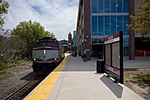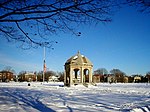The Satanic Temple
The Satanic Temple (TST) is a non-theistic religious organization and new religious movement that is primarily based in the United States, with additional congregations in Australia, Canada, Finland, Germany, and the United Kingdom. Co-founded by Lucien Greaves, the organization's spokesperson, and Malcolm Jarry, the organization uses Satanic imagery to promote civil rights, egalitarianism, religious skepticism, social justice, secularism, and the separation of church and state, supporting their mission "to encourage benevolence and empathy [among all people]." The Satanic Temple has utilized religious satire, theatrical ploys, humor, and legal action in their public campaigns to "generate attention and prompt people to reevaluate fears and perceptions", and to "highlight religious hypocrisy and encroachment on religious freedom."The Satanic Temple does not believe in a supernatural Satan; instead it employs the literary Satan as a metaphor to promote pragmatic skepticism, rational reciprocity, personal autonomy, and curiosity. Satan is thus used as a symbol representing "the eternal rebel" against arbitrary authority and social norms. TST adherents generally refer to their religion as "Satanism" or "Modern Satanism", while others refer to TST's religion as "Compassionate Satanism" or "Seven Tenet Satanism".The organization's participation in public affairs includes political actions as well as lobbying efforts, with a focus on exposing Christian privilege when it interferes with personal religious freedom. It considers marriage a religious sacrament that should be governed under the First Amendment's protection of religious freedom which should prevail over state laws. Because the group regards inviolability of the body as a key doctrine, it also views all restrictions on abortion, including mandatory waiting periods, as an infringement on the rights of Satanists to practice their religion.
Excerpt from the Wikipedia article The Satanic Temple (License: CC BY-SA 3.0, Authors).The Satanic Temple
Sergeant James Ayube Memorial Drive, Salem
Geographical coordinates (GPS) Address Nearby Places Show on map
Geographical coordinates (GPS)
| Latitude | Longitude |
|---|---|
| N 42.5313609 ° | E -70.8913727 ° |
Address
Sergeant James Ayube Memorial Drive
Sergeant James Ayube Memorial Drive
01970 Salem
Massachusetts, United States
Open on Google Maps










